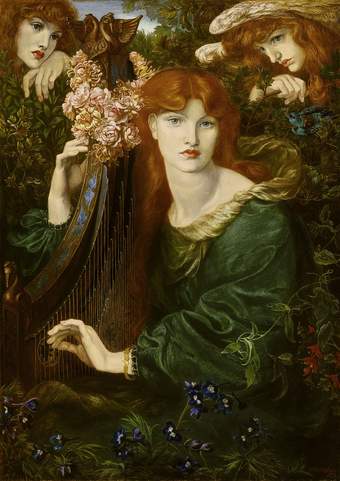
Dante Gabriel Rossetti La Ghirlandata 1873 Guildhall Art Gallery, City of London

Dante Gabriel Rossetti La Ghirlandata 1873 Guildhall Art Gallery, City of London
Tate Britain presents a major exhibition charting the romance and radicalism of the Rossetti generation – Dante Gabriel, Christina and Elizabeth (neé Siddal) – showcasing their revolutionary approach to life, love and art. Moving through and beyond the Pre-Raphaelite years, the exhibition features over 150 paintings and drawings as well as photography, design, poetry and more.
This is the first retrospective of Dante Gabriel Rossetti ever held at Tate and the largest exhibition of his work in two decades. It spans the two avant-garde movements that he originated, bringing together all three of his Pre-Raphaelite oil paintings and many of his later iconic Aesthetic canvases. This is also the first retrospective of Elizabeth Siddal for 30 years, featuring her rare surviving watercolours and important drawings. Christina and Dante Gabriel’s poetry are interwoven with these artworks through spoken word and beautifully illustrated editions of their work.
The Rossettis led a progressive counterculture, blending past and present to reinvent art and life for a fast-changing modern world. The children of an Italian revolutionary exile, they grew up in London in a scholarly family and they began their artistic careers as teenagers. The exhibition begins with a celebration of their young talent, opening with Christina’s first edition of poems, published when she was 16, and Dante Gabriel’s Ecce Ancilla Domine (The Annunciation) 1850, the stark and evocative painting for which Christina and their brother William Michael posed. This is surrounded by an audio installation of Christina’s poetry and followed by examples of Dante Gabriel’s teenage drawings, reflecting his precocious skill and his enthusiasm for original voices like William Blake and Edgar Allan Poe.
Works from the Pre-Raphaelite years demonstrate how the spirit of popular revolution inspired these artists to initiate the first British avant-garde movement, rebelling against the Royal Academy’s dominance over artistic style and content. More personal forms of revolution are explored through the Rossettis’ refusal to abide by the constraints of Victorian society. Works such as Dante Gabriel’s Found begun 1854, Elizabeth Siddal’s Lady Clare 1857 and Christina’s poem The Goblin Market 1859 show how they questioned love in an unequal and materialist world.
Following new research, Elizabeth’s surviving watercolours are shown in a two-way dialogue with contemporary works by Dante Gabriel, exploring modern love in jewel-like medieval settings. As a working-class artist who was largely self-taught, Elizabeth’s work was highly original and inventive, but has often been overshadowed by her mythologisation as a tragic muse. Her and Dante Gabriel’s work together marks the turning point from Pre-Raphaelitism to the imaginative and expressive Aesthetic style.
The exhibition takes a fresh look at the fascinating myths surrounding the unconventional relationships between Dante Gabriel, Elizabeth Siddal, Fanny Cornforth and Jane Morris. The Aesthetic portraits from the later part of Dante Gabriel’s career, such as Bocca Baciata 1859, Beata Beatrix c.1864-70 and The Beloved 1865-73, are shown in the context of the achievements and experiences of the working women who inspired them. The exhibition also explores how the poetic and artistic evolution of the femme fatale informed works such as Lady Lilith 1866-8 and Mona Vanna 1866.
Alongside art and poetry, visitors can experience how the Rossettis’ trailblazing new lifestyles transformed the domestic interior through contemporary furniture, clothing and design. The exhibition concludes by showing how the Rossettis inspired the next generation, including William Michael’s teenaged children who ran the anarchist magazine The Torch, and how they continue to influence radical art and culture to this day.